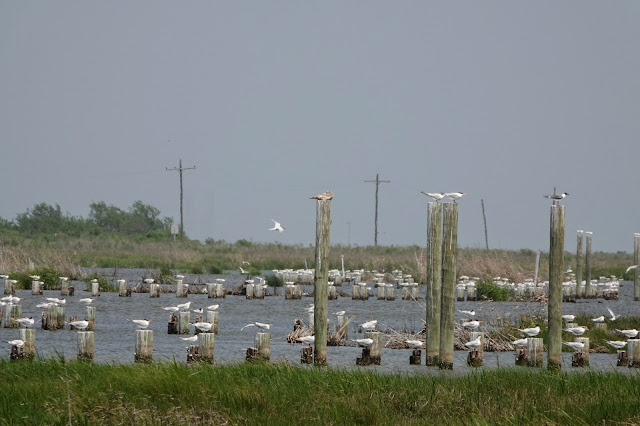There's only one road that takes you to the state park, and it first takes you past Sabine Woods. As we drove past I saw people photographing birds right at the entrance. My curiosity got the best of me and I begged my husband to stop. I hopped out, ran back and saw a cuckoo, tanagers and warblers in the two trees right at the entrance! Wow! I was excited that our campground was only seven minutes away! I could hardly wait to get the RV setup and return to explore.
You can't miss Sabine Woods. Just look for the dozens of cars lining the road.
I returned and was just astounded at not only the variety of birds, but the abundance. I never thought I'd take a blase attitude towards tanagers, grosbeaks and buntings, but it happened! While the area is a relatively small 27 acres, it has a nice variety of habitat, shady areas for thrushes, trees and edges for songbirds, and fields for buntings. When I first discovered the field, it was popping with blue- Blue Grosbeaks and Indigo Buntings were abundant!
This bird sanctuary is owned by TOS (Texas Ornithological Society). It's open 24 hours and the fee is $10/day. Definitely worth it! In 5.5 hours I found 81 species of birds and left feeling that this may be the most exciting birding location I've enjoyed in the United States. In talking with a few other locals, I found they all shared my friend's opinion that High Island used to be THE place during migration, but something has changed and those legendary stories that we've all heard just aren't happening anymore. Sabine Woods is the place to be. Now being there for a fallout would be a different story. A fallout is when weather, wind and particularly rain, is pushing south against the birds as they are flying north. In that scenario, they would immediately land and rest. Every birder's dream.
It's pretty common to see large groups of people pointing binoculars and large lenses at the trees. This is a good sign you are missing out on something! In a few places within the preserve, you'll find water features meant to draw birds with benches inviting viewers to stay awhile. As the sun was setting, a group of us gathered to watch as four species of thrushes and various warblers appeared for a drink or a quick bath. I chatted with a few locals who gave me some great advice on birding the area. I was shocked to learn that a man who had some mobility challenges had sat on this very bench the day before from 8am-4pm and was able to see 21 species of warblers come in to the pond! That's more than I saw walking around the place! I'd be curious to know what his total species count was for the day. Definitely a delightful way to spend the day whether you are able to walk thru the park or not.
I must also tell you about birding nearby Sea Rim state park, a great location that includes the Gulf beach and brackish marshes. When a Blue Grosbeak welcomed us to our campsite, I knew this was going to be a great place. In the morning I woke to the kek-kek-keking of a King Rail, a bird I'd struggled for years to see! Watching one tussle with some Great-tailed Grackles in my own campsite was quite a thrill. Large numbers of birds congregate on what's left of the marsh boardwalk trail, a casualty of hurricanes past. On my last morning, I nearly stepped on a well-camoflauged Common Nighthawk resting among a rocky patch in the grass. When he gave a quick flutter to warn me of his presence, I stepped back and took photos as he swiftly went back to sleep. Afterwards I found four more resting in the grassy median or along the road, not far from the nesting Wilson's Plovers.
After two nights at Sea Rim, we moved to High Island RV Park. We had planned to camp right on the beach, but had second thoughts after hearing of vehicles getting stuck in the sand. I called High Island RV Park and though they were full, they gave us a dry camping spot in their storage lot for the night. Perfect! We disconnected and headed straight for the Bolivar Flats Shorebird Sanctuary.
This is another spot that is very popular during migration. We didn't have much time to spend here, but I enjoyed seeing a huge number of birds, many different species on the beach. My favorite sightings were Black Terns, my first time seeing them in breeding plumage and a white morph Reddish Egret doing its crazy hunting dance. I love the blue legs!

In the morning I walked from our campsite to Hooks Woods and then Boy Scout Woods. I have to say, in comparison to Sabine Woods, these were quite disappointing. Boy Scout Woods seemed pretty socked in so while I heard a decent variety of birds, finding them was a bit more difficult. If I was not able to identify birds by sound, I would have been very frustrated. I think the only wildlife photo I took was of this cottontail.





































No comments:
Post a Comment